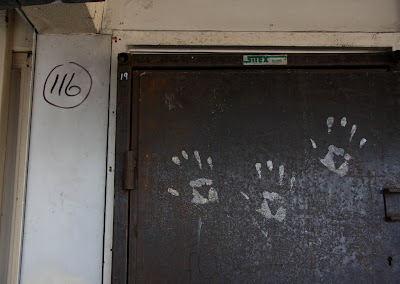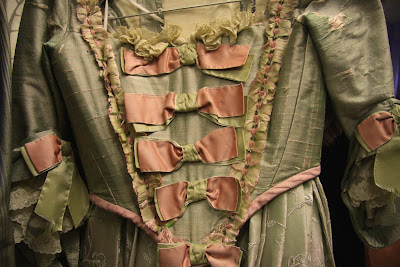Once the site of some 2,000 homes, it is now an empty shell that awaits demolition as part of a £1 billion regeneration scheme. Demolition has been underway since 2009, but several of the buildings still remain. And so do a small clutch of residents.
Photographer Anna Batchelor and artist Sarah Colson have pieced together the shards of this broken community in a rare exhibition that reflects the life of the Ferrier Estate. Presented in a corridor of the estate itself, the exhibition, entitled 'Home Sweet Home', combines Batchelor's portraits of the remaining residents with Colson's cross-stitched samplers of their most poignant quotes.
Batchelor and Colson chose the location for their exhibit, which closes this weekend, because it was one of the few areas on the Ferrier Estate that was still occupied. Batchelor and Colson hung their pieces themselves onto the peeling paintwork of the corridor's walls. .
 Arriving into the estate feels a long way from any art gallery. Instead of bright lights, white walls and trendy gallery goers, there are cranes, rubble and emptiness. I meet Colson at the station and she leads me to the exhibit, which is just as well as I would have struggled to find it by myself. No one is around to ask for directions.
Arriving into the estate feels a long way from any art gallery. Instead of bright lights, white walls and trendy gallery goers, there are cranes, rubble and emptiness. I meet Colson at the station and she leads me to the exhibit, which is just as well as I would have struggled to find it by myself. No one is around to ask for directions.
"Home Sweet Home," reads a cross-stitched sign, and we are led up some concrete steps to the exhibit.
Perhaps it is the power of Batchelor's photographs, the tenderness of Colson's stitching or the relevance of the surroundings, but I am moved beyond words.
Batchelor's photographs give an evocative snapshot of the lives of the residents who have yet to be relocated. When balanced with the resonating quotes hand stitched into Colson's samplers you get a raw and emotional view of the human impacts of this demolition. This is art in its purest form: touching, thought provoking, and very much real.
Just opposite the exhibition diggers and construction staff are busy at work on the new housing estate. With plans for a more modern and greener estate, there is no doubt that it will be an improvement. But behind Batchelor's photographs, just on the other side of the wall, families continue to live. They are part of a lost community.
 "It was like a sunflower opening up, creating opportunities for people."
"It was like a sunflower opening up, creating opportunities for people."When the estate opened in the 1970s it was an example of modern, brutalist architecture that had none of the negative connotations and history that it does today.
 Teresa:
Teresa:"Photographed at home with parrot Charlie. Building work had begun behind Teresa's hoome and the three other sides of the square were due for demolition in the coming weeks. Only one neighbour was left in the row of twelve houses and there was no idea when or where she would move. With all the building work Teresa feels the estate is now like a war-zone."
 Batchelor's inspiration for this exhibit came from this building. She lived nearby the estate and was passing one evening when she noticed a solitary light shining from a solitary window of the huge tower block. She was intrigued to find out who lived there and to use her experience as a photo journalist to tell the story of the isolation and dispersed community on Ferrier Estate.
Batchelor's inspiration for this exhibit came from this building. She lived nearby the estate and was passing one evening when she noticed a solitary light shining from a solitary window of the huge tower block. She was intrigued to find out who lived there and to use her experience as a photo journalist to tell the story of the isolation and dispersed community on Ferrier Estate.  Walking through the estate and reading the quotes from many of its remaining residents, you get the sense that Ferrier used to be a thriving community. Boarded up shop fronts once housed a wealth of amenities and looked out over communal gardens. Now all that remains is a pharmacy, a church and an offlicence where the owner shouts, "we're open!" to us as we pass. Access to the front entrance of his shop has been cut off due to building work, so he stands guard outside the back door waiting for customers. His enthusiasm tells me we are probably his first of the day.
Walking through the estate and reading the quotes from many of its remaining residents, you get the sense that Ferrier used to be a thriving community. Boarded up shop fronts once housed a wealth of amenities and looked out over communal gardens. Now all that remains is a pharmacy, a church and an offlicence where the owner shouts, "we're open!" to us as we pass. Access to the front entrance of his shop has been cut off due to building work, so he stands guard outside the back door waiting for customers. His enthusiasm tells me we are probably his first of the day.  As we leave we walk down rows of abandoned homes; homes with locked gates, overgrown gardens and paths scattered with dead leaves and empty cans. The windows are blocked out and the buildings look desolate and dejected.
As we leave we walk down rows of abandoned homes; homes with locked gates, overgrown gardens and paths scattered with dead leaves and empty cans. The windows are blocked out and the buildings look desolate and dejected.  Then we come to the final house in the row. It is at the end of an abandoned street with weeds and metal fences for neighbours.
Then we come to the final house in the row. It is at the end of an abandoned street with weeds and metal fences for neighbours.Lace curtains are hanging in the window and a bright red rose is growing in the garden.
For more about Sarah Colson, see www.sarahcolson.com
Libby













































